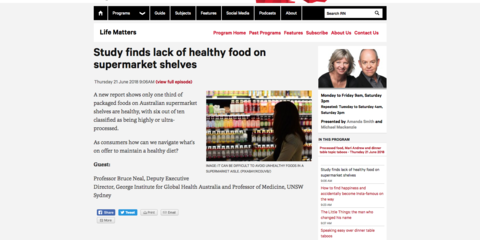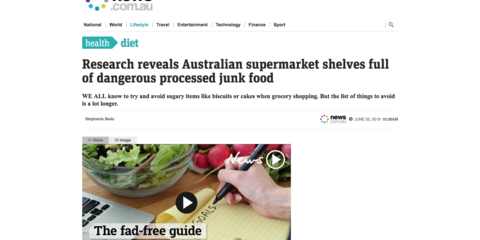
Australia's supermarket shelves full of highly processed and highly unhealthy foods
Six out of ten Australian packaged foods are highly or ultra-processed, more than half are discretionary/junk foods and only one third are healthy, according to a new analysis by The George Institute for Global Health.
The authors of the findings published in Nutrients say Australians deserve healthier options and urgent action is needed to improve the nutritional make-up of packaged foods.
Lead researcher Michelle Crino said: “Our research shows that Australia’s packaged food environment is full of foods laden in sugar, fat and salt that are also highly processed. It’s not just a few packaged foods that we need to be aware of. Our supermarket shelves are full of products that are making us fat and making us sick.”
Researchers examined more than 40,000 packaged food items ranging from breads, to sauces, confectionary, canned foods, oils and dairy products. They determined their Health Star Rating (HSR), whether they were core or discretionary products and the extent of their processing1. They also looked at the proportion of foods meeting reformulation targets for sodium, saturated fat and sugar.
Key findings
53% of the Australian packaged food supply is comprised of discretionary products – energy dense and nutrient-poor foods such as sweetened soft drinks/cordials/flavoured waters, biscuits, chocolate, meat pies, butter and salty snacks.
Just 47 per cent are considered core foods – including fruit and veg, legumes, nuts and seeds, cereal grains, lean meats, fish and dairy products – which the Australian Dietary Guidelines say should make up the majority of our diet.
Of the 40,664 products analysed just over a third (38 per cent) had an HSR of 3.5 or higher, which usually indicates a basic level of healthfulness.
61% were found to be ultra-processed, 18% moderately processed and 21% less processed foods. Almost all (98%) convenience foods – including ready-to-eat meals, pre-prepared sauces or dressings, canned or processed meats, frozen meals and desserts - fell in the ultra-processed category.
Professor Bruce Neal, of The George Institute for Global Health, said shoppers are being bombarded with junk foods and it is little wonder we are in the midst of an obesity epidemic.
“It’s a sad reflection of the state of our food industry that half of all packaged foods are essentially junk foods that we should only be eating occasionally. We have to find a way to make junk food less profitable. Because what works for the industry’s bottom line is a disaster for the nation’s waistline.
‘’Industry tell us it’s all about personal choice and free will. But, Australians haven’t chosen to be obese – they’re obese because selling cheap, unhealthy food everywhere, all the time, is how industry profits are maximised. We need to work with government to find a balance between supporting industry, while also looking after our health.
‘’This doesn’t mean putting people out of business. It’s just a matter of nudging choices back towards healthier options – more fresh fruit and veg in the aisles, better labelling so people know what to choose and checkout counters without the junk food. We also need manufacturers to stop adding so much salt, sugar and harmful fat during processing’’ Professor Neal said.
Michelle Crino said the Australian Healthy Food Partnership is currently developing updated salt, fat and sugar targets and this latest research could be used to help identify key product categories where public health action is most needed.
“We found that just half of packaged foods had targets for salt reduction and a good third of these hadn’t met them2. And less than one per cent of all packaged foods items had to meet any saturated fat targets. There is a clear gap where public health intervention is required.”
The findings come just months after a UK study published in the British Medical Journal revealed that a diet high in ultra-processed foods was linked to a heightened risk of cancer.3
Read the full study paper in Nutrients journal.
2 21,382 of the products surveyed had sodium targets previously set by the Food and Health Dialogue, with 66 per cent meeting them. There are currently no reformulation targets, but new targets are being worked on by the Government’s Healthy Food Partnership Reformulation Working Group. Link for more details: http://health.gov.au/internet/main/publishing.nsf/Content/reformulation







